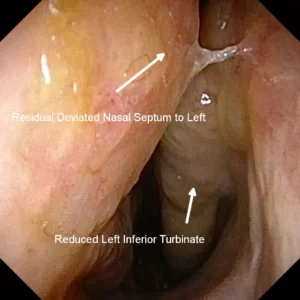The Ultimate Guide to ClariFix (2023) - The Patient Experience
A runny, stuffy nose is one of the most common complaints amongst patients who present to ENT Specialists. This is frequently dismissed as a ‘sinus’ problem, but more often than not is commonly due to allergies. ClariFix is a novel treatment option for patients who find using nasal sprays and antihistamines bothersome. Read on to find out more about a patient who underwent the ClariFix procedure and how it helped her.
Melissa, a 38 year old female, had been suffering with ‘sinus’ issues since she was young. She remembers having episodes of incessant sneezing, as well as a runny nose and nasal congestion through her childhood. She used a nasal spray when she was young, but found that the symptoms improved as she got older. Eventually, she started her university education in Australia and New Zealand, and her nose did not give her any further trouble.
Melissa returned to Singapore in early 2020 just before the COVID pandemic struck to take up a new job position. Since then, she found that her nasal symptoms had returned with a vengeance, with much of the same symptoms that she experienced in childhood. Her nose was constantly blocked, especially at night, which caused her to breathe with her mouth open. She had a persistent runny nose, and constant phlegm in her throat from post-nasal drip. She saw a GP multiple times, and was prescribed intra-nasal sprays, decongestants, and anti-histamines; all of which helped somewhat but were not as effective as she would have liked.
She sought out an ENT Specialist, who informed her that her nasal septum was deviated to the right and that her nose was very congested due to inferior turbinate hypertrophy. Melissa subsequently underwent surgery, consisting of a septoplasty and inferior turbinoplasty in mid-2020.
Post-operatively, she felt that there was improvement in her nasal obstruction and congestion, but the runny nose and post-nasal drip persisted despite restarting the nasal sprays and using them religiously. After finding out about the ClariFix procedure, she contacted us for a consultation.
A comprehensive history and physical examination including nasoendoscopy was performed. This confirmed that the turbinates had been reduced and were now moderate in size, with a persistent mild septal deviation to the left. The tissues of the nose looked pale and edematous, with evidence of allergic mucus throughout. A skin prick test was done for Melissa, which revealed allergies to common dust mites – Dermatophagoides pteronyssinus, Dermatophagoides farinae and Blomia tropicalis.

Endoscopic photo showing previous right inferior turbinate reduction

Endoscopic photo showing residual left septal deviation and previous left inferior turbinate reduction

Endoscopic photo showing post-nasal drip in the back of the nose
After obtaining all the necessary information, treatment options were discussed with Melissa. The conservative option would be to continue the nasal sprays, possibly at a higher dose, and add either a regular intranasal antihistamine or oral antihistamine. Melissa was not keen on this option as she had tried it before and did not see much success. An alternative option, as she had allergies to dust mites, would be to consider immunotherapy in an attempt to desensitize her to dust mites. Melissa found this treatment option acceptable, but balked at the treatment duration of 2-3 years, which meant that she still had to suffer from her symptoms for an extensive period of time. The final option of Clarifix cryotherapy was then discussed with her. She found this option attractive as it would potentially give her immediate and prolonged relief from her symptoms and decided to go ahead with it.
Melissa underwent Clarifix nasal cryotherapy as a day surgery procedure, and was in and out of the clinic in less than 2 hours. On her first follow-up visit 1 week later, she reported a 30% improvement in her symptoms of nasal congestion, runny nose and post-nasal drip. On further follow-up at 2 and 6 week intervals, the improvement was more marked, at approximately 60-70%. She was thrilled with the outcome of the procedure and has since remained well and symptom free. She is considering starting immunotherapy at her next scheduled follow-up visit to further ameliorate her symptoms.
What Is Chronic Rhinitis?
Chronic rhinitis is defined as inflammation of the nasal mucosa causing excessive mucus secretion. Chronic rhinitis symptoms include a runny nose, congestion, nasal itching and sneezing. Rhinitis can be either allergic, non-allergic or mixed rhinitis (both allergic and non-allergic). Nasal nerves regulate functions of the nose such as nasal secretions. It is thought that interrupting these nerves, especially the posterior nasal nerve (PNN) results in the reduction of nasal symptoms such as runny nose and nasal congestion.
How Does ClariFix Work?
It is a clinically-proven, minimally invasive cryotherapy (localized freezing) that uses a cooling probe to freeze a small, inflamed area in the back of the nose. It is used to help treat people who suffer from chronic rhinitis who either are unable to tolerate nasal sprays, or find nasal sprays troublesome to use. Both patients with allergic and non-allergic rhinitis are suitable for this procedure. We are one of the first ENT specialists in Singapore to have experience with ClariFix in Singapore.
Will ClariFix Work for Me?
In clinical studies done by the manufacturer to gain USA Food & Drug Administration (FDA) clearance for the device, 80% of patients reported long-lasting relief of their chronic rhinitis and associated nasal symptoms It usually takes between 2 and 6 weeks post-treatment to see these improvements. After this period, your need for nasal sprays and other medications are expected to decrease. Of course, this can vary from patient to patient. The results of the procedure may or may not be permanent, but you should expect the symptom relief from the ClariFix procedure to last at least 1-2 years, according to the current data available.
How About ClariFix Australia / ClariFix New Zealand?
We have received many queries from Australia and New Zealand regarding the ClariFix procedure, as it is not available in those countries at the moment. As a result, we have had a fair number of patients from Australia, New Zealand and surrounding countries come to see us for the ClariFix procedure. It can be a day procedure, with no prior preparation, and the ability to travel immediately.
You may visit our website here; or the manufacturer’s site here for more information regarding the ClariFix procedure. Please contact us if you have further queries about the ClariFix treatment.








